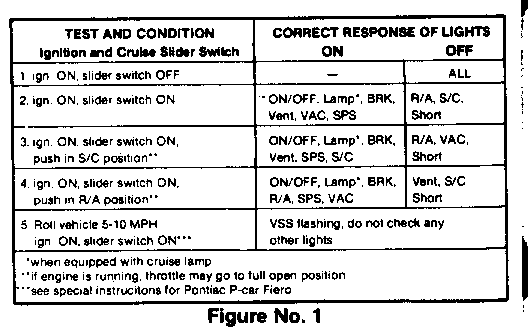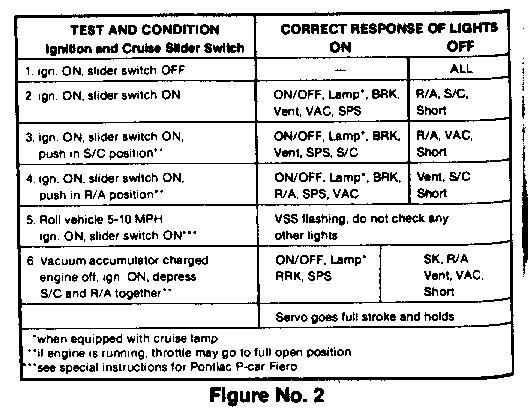CLARIFICATION AND REVISION OF DIAGNOSTIC ROUTINE,C/C SYSTEM

MODIFICATION OF DIAGNOSTIC ROUTINE ON THE CLARK BROS., KENT-MOORE, AND SPECMO CRUISE CONTROL "QUICK CHECKERS"
Model and Year: ALL CHEVROLET PASSENGER AND LIGHT -------------- DUTY TRUCKS WITH CRUISE CONTROL
TO: ALL CHEVROLET DEALERS
The existing diagnostic test procedure listed on the reverse side of these "Quick Checkers" includes five troubleshooting steps. Each step provides a reliable indication--by the illumination of a light--of the electrical continuity of specific components in the cruise control system. A large number of GM Dealership service personnel are under the misunderstanding that these same five steps, also, verify the condition of the cruise vacuum system. This is not the case. To clear up this mistaken assumption, an essential addition has been incorporated in the existing test procedure:
TEST AND CONDITION CORRECT RESPONSE OF LIGHTS Ignition and Cruise Slider Switch ON OFF --------------------------------- -------------------------- 1. ign ON, slider OFF ALL
2. ign ON, slider switch ON ON/OFF, Lamp*, BRK R/A, S/C, Vent, VAC, SPS Short
3. ign ON, slider switch ON, ON/OFF, Lamp*, BRK R/A, VAC, push in S/C position** Vent, SPS, S/C Short
4. ign On, slider switch ON, ON/OFF, Lamp*, BRK Vent, S/C, push in R/A position** R/A, SPS, VAC Short
5. Roll vehicle 5-10 MPH VSS flashing, do not check any ign ON, slider switch ON*** other lights
6. Vacuum accumulator charged, ON/OFF, lamp* SK, R/A, engine off, ign ON, depress RRK, SPS Vent, VAC, S/C and R/A toghether** Short
Servo goes full stroke and holds
* when equipped with cruise lamp ** if engine is running, throttle may go to full open position *** see special instructions for Pontiac P-car Fiero
A sixth step (see figure 1) has been added. This step allows the technician to check the cruise system vacuum integrity from the accumulator tank through the vacuum servo.
To obtain the new diagnostic stickers, contact your zone office or divisional service contact representative. Place the sticker over the one presently on the "Quick Checker." If additional stickers are needed in the future, contact
SPECMO Enterprises 2344 N. Woodward Ave. Royal Oak, MI 48073 (313) 399-5645


General Motors bulletins are intended for use by professional technicians, not a "do-it-yourselfer". They are written to inform those technicians of conditions that may occur on some vehicles, or to provide information that could assist in the proper service of a vehicle. Properly trained technicians have the equipment, tools, safety instructions and know-how to do a job properly and safely. If a condition is described, do not assume that the bulletin applies to your vehicle, or that your vehicle will have that condition. See a General Motors dealer servicing your brand of General Motors vehicle for information on whether your vehicle may benefit from the information.
